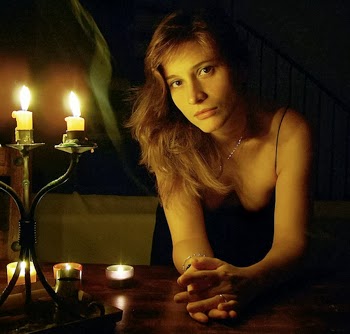This light is motivated. I like this image because every individual is illuminated by a couple of candles, and in the second act Amanda, Tom, Jim, and Laura need to be seen only by candlelight after the electricity is shut off.
Non-Motivated light. Through the dance hall window a bright light could shine out and cast shadows of the dancers in the alley. This should look almost artificial (almost like a dream).
Motivated. The lights inside the home should all put out a warm, amber glow to create the environment of a home.
Motivated. The alleys should have a warm glow that reflects the sunlight that is hitting the bricks. The intensity will change depending on the time of day.
Motivated. Light is seen through the windows of the Wingfield apartment throughout the entire show. When the areas are called to be dimly lit they should only be illuminated by the soft light coming through the window curtains.
Motivated. The dance hall will have a light such as this one from Burt's club in the 1930's.
Motivated. The intensity of light in this image should be captured in the Wingfield apartment when an area is to be dimly lit. This will allow the characters to be seen without drawing to much attention away from the characters that should be in the hot spot.
Motivated. In the end Laura is illuminated by candles in the old candelabra. This image shows how intense the light should be on Laura's face in her final moment.
Motivated. The light from the street lamps should be seen from the back of the alley of the Wingfield apartment. The stark white light will have a great contrast to the amber sunlight that shines down the alley.
Non-Motivated. I like the harsh shadows that a bright white light would put on the dancers. Tom dreams of being carefree as he looks toward the dance hall and the moon, so I think that these two sources should seem artificial. This would represent how unrealistic his dreams seem in his current situation.
Motivated. This is another example of how the sun would light up the alley.
Motivated. The shadows from the window will move around the room at different times of the day, and this image shows the shadows that might be cause from curtains or blinds that would move across the apartment. I also like the dust that defines the beams of light. I think this would help portray a working class family's living area in the populated city.
Motivated. The candles will be used throughout the second half when the electricity is cut off.
Non-Motivated. This beam could represent the moon beam on Amanda and Laura as they look up to the moon before the gentleman caller comes to the house. This artificial beam, again, represents the unrealistic dreams that this family has.
Motivated. I love how this photo shows the natural light coming through the windows, yet has a chandelier lighting the dining room. This is almost exactly what I pictured for the Wingfield apartment.
Motivated. This warm glow is an example of how the lamp on the wall might reflect light off the white interior of the apartment.
Motivated. The shadows on this picture allow me to see where several different sources of light are coming from without actually seeing the source itself. This is a great example of a 1930's living space.
Non-Motivated. The artificial light that is shining on the couple is not created by the moon they are looking at, and this is what I want to see when Laura and Amanda gaze up at the moon.
Motivated/Non-Motivated. Between each streetlamp there is a dark area that is not illuminated. This would create a wonderful mood in the alley leading to the fire escape.
Motivated. In the image above I can see how the lights could be apart of the apartment building instead of individual street lamps.
Motivated. St. Louis was a buzzing city with cinemas and dance halls all around the area. The lights from the cinemas could be seen softly shining on the side of the building that are not obstructed by another structure.
Motivated. These are lights that hung in the radio city music hall in the 1930's.
Motivated. I love the candlesticks that are used in this photo. Laura could use candles like these in the candelabra that she holds at the end of the play.
Motivated. The intensity of the photo is too string, but I do think that it shows a nice contrast of color between the sky and the lamps.
Motivated. The street lamps in this image have a nice glow that is created by the smog of the area. This would add information on the air quality that the Wingfields breath in this busy city.


























































